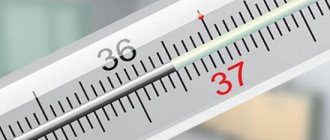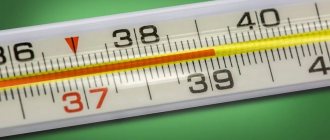What is low-grade fever
Low-grade fever is a slight increase in body temperature above normal. Previously, this term was used quite actively, including abroad (low-grade fever), but now it is not in the international classification of diseases. Officially, the condition associated with an increase in body temperature sounds like fever of unknown origin. To make this diagnosis, the following conditions must be met:
- body temperature 38.3 °C and above;
- the duration of the condition is more than three weeks;
- unclear diagnosis after inpatient examination within a week.
A person's body temperature fluctuates throughout the day and changes depending on circumstances. The body under normal conditions maintains it within a certain range, regardless of environmental changes. Temperatures are usually a little higher in the evening, around 8:00 pm, and lower in the early morning. This is circadian type variability. The temperature recorded in the armpit ranges in a healthy person from 35.2 °C to 37 °C.
Indicators of the so-called subfebrile temperature are in the range of 37.1 - 38 °C. These values may be enough for a person to feel unwell, lack of strength, lack of appetite, drowsiness and discomfort in the body. But often the temperature is not accompanied by other symptoms, and in some cases its increase is considered normal. It should be noted that all of these symptoms are nonspecific and can occur without connection with an increase in body temperature.
Unlike high fever, an increase in body temperature of 1–2 degrees is not dangerous for the body. Low-grade fever does not lead to deformation of protein molecules and cell death. The norms for the duration of this state of the body are determined by the doctor.
Treatment
Help before diagnosis
With elevated low-grade fever that lasts less than 2 days, specific treatment is not required. A long duration of symptoms indicates the presence of a pathological process, which is an indication for seeking medical help. Until the cause of the fever is determined, the patient should be given plenty of warm fluids. Physical cooling methods are used - rubbing, cold compresses. It is recommended for adults to drink antipyretics to bring down the temperature when the thermometer readings are more than 38.5 ° C; children are given antipyretics when the temperature is above 38 degrees.
Conservative therapy
Medical tactics depend on the cause of symptoms and the general condition of the patient. In case of high fever, temperature measurements in the hospital are carried out every 2-3 hours to assess the dynamics. In children, impaired thermoregulation is sometimes accompanied by convulsions, so when an elevated febrile temperature is detected, they are immediately given antipyretic medications. A prerequisite is adequate etiotropic and pathogenetic therapy, against the background of which thermometry indicators are normalized. For therapeutic purposes use:
- Antibiotics
. Medicines are selected empirically, the treatment regimen is adjusted after receiving the culture results. For massive purulent processes, combinations of 2 or 3 drugs are recommended, which are administered parenterally in high therapeutic doses. - Antiviral agents
. For influenza, specific medications are indicated to block the multiplication of the virus and speed up recovery. For the treatment of viral hepatitis, medications have been developed that reduce the viral load and alleviate the general condition. - Anti-inflammatory drugs
. Nonsteroidal drugs block the synthesis of prostaglandins and cytokines acting on the thermoregulatory center and reduce the activity of the inflammatory process. NSAIDs are used that have powerful antipyretic properties. - Glucocorticoids
. Prescribed for severe systemic autoimmune or allergic reactions that do not respond to other therapy. They are used with caution for infections, since adrenal hormones suppress the activity of the immune system. - Infusion solutions
. If the temperature is above 38° C and the patient’s condition is serious, rehydration and detoxification therapy are required. Saline solutions containing essential electrolytes are poured in. Treatment is supplemented with diuretics. - Vitamins
. In case of sluggish processes, ascorbic acid and B vitamins are used to stimulate the immune system. Metabolic drugs that improve metabolic processes in cells and have a tonic effect are effective. The products are combined with antioxidants.
Surgery
If large abscesses or foci of osteomyelitis are detected, they must be drained and the resulting cavities must be washed with antiseptic solutions. For diseases manifested by an “acute abdomen,” abdominal surgery with wide access is indicated to remove altered areas of the intestine, followed by sanitation of the abdominal cavity. For malignant tumors, radical surgical interventions are performed (removal of the tumor along with the surrounding tissue and regional lymph nodes), combined with radiation and chemotherapy.
Symptoms of low-grade fever
In some cases, a rise in temperature to 37 can be caused by weather, diet, stress and other minor changes, in others it is a symptom of disease. Look out for the following signs:
- the temperature systematically rises and falls over several days for no apparent reason;
- you do not have ARVI or exacerbation of chronic diseases, there is no pain, runny nose, cough or other symptoms of disease;
- you have not been immunized or taken new medications;
- there were no shocks associated with stress, you eat well and get enough sleep.
If all the criteria are met, and the temperature continues to remain above 37 °C, this is a reason to consult a therapist. Especially if you notice in yourself:
- neoplasms (nodules) on the skin;
- swollen lymph nodes;
- bruises that appeared from nowhere;
- severe loss of appetite;
- rash;
- muscle joint pain;
- problems with the gastrointestinal tract.
The doctor will examine your medical history and complaints, and then prescribe the necessary tests and examinations.
Causes of low-grade fever
An examination by a specialist is necessary because an elevated temperature can be a sign of a wide range of illnesses, ranging from minor to very serious. Thus, a temperature of 37–38 °C is typical for:
- overheating of the body (due to hot weather, inappropriate clothing, in a bath or sauna), heat stroke;
- teething in infants (in this case the temperature rises to higher levels, which is normal);
- vaccinations (the body's natural immune response);
- side effects from certain medications.
You can read the continuation of the article by following the link to RBC Style.
Diagnostics
A general practitioner examines patients with elevated temperatures. The scope of diagnostic measures depends on the clinical picture and the presence of additional symptoms; if there are clear signs of damage to a certain system, its targeted diagnosis is carried out. In case of prolonged fever of unknown cause, the examination is performed according to a standard algorithm, which includes advanced laboratory methods and instrumental imaging. The most informative studies:
- Blood analysis
. In the general analysis, attention is paid to signs of the inflammatory process (leukocytosis, increased ESR). The levels of acute phase proteins and antinuclear antibodies are measured to exclude autoimmune processes. During the period of acute inflammation, the procalcitonin test is informative. To assess cardiac function, an antistreptolysin and troponin test is performed. - Hemoculture
. Blood sampling is carried out during the period of the highest temperature, at least 3 times. The material is inoculated on selective nutrient media; if a large number of bacterial colonies are present, septicemia is diagnosed. Additionally, blood is examined using ELISA, RIF - express methods for detecting antibodies and antigens of pathogens. - Bacteriological studies
. In addition to blood, stool and urine samples and sputum are used to isolate pathogens. If neurological symptoms are detected at elevated temperatures, cerebrospinal fluid is taken. After identifying colonies of pathogenic microorganisms, a sensitivity test to antibacterial drugs is performed. - Radiography
. If elevated temperature persists for a long time, chest radiographs are taken in two projections, in which areas of darkening, cavities with a horizontal fluid level, and deformation of the bronchial tree can be detected. Plain radiography of the abdominal cavity helps to exclude abscesses, large inflammatory conglomerates and perforations of a hollow organ. - Ultrasonography
. To clarify the cause of febrile fever, echocardiography is performed, during which signs of infective endocarditis, valve vegetation, and pathology of large arteries are determined. To exclude endocrine disorders, an ultrasound scan of the thyroid gland, parathyroid glands, and adrenal glands is performed. - Highly specific imaging techniques
. If the cause of the elevated temperature cannot be determined by standard methods, scintigraphy of the whole body with gallium is indicated, which makes it possible to identify chronic abscesses and space-occupying neoplasms. Osteomyelitis is confirmed by bone scintigraphy with technetium. If meningitis is suspected, a CT or MRI of the brain is recommended.
If your body temperature is high, drinking plenty of fluids is recommended.
2. Reasons
There are a great many reasons for an increase in temperature, many of which are purely situational, but in this case, low-grade fever is always transient in nature and passes more or less quickly. These are, for example, temperature fluctuations during the day (slightly higher in the evening), in response to intense physical activity, overheating, a stressful situation, or (in women) the ovulation phase of the cycle.
An increase in temperature is one of the most common, almost always occurring reactions to an infection, no matter what pathogen it is caused by; Accordingly, persistent low-grade fever often turns out to be a symptom of a chronic infectious-inflammatory process, with which the immune system has entered into a kind of “clinch” without a clear “winner.”
The causes can also be HIV/AIDS, oncological processes, endocrine disorders (usually thyroid pathology), autoimmune diseases, asthenic conditions after an illness, anemia, viral hepatitis, chronic inflammation of the structures of the nasopharynx, kidneys, reproductive system, etc.; eroding and ulcerating diseases of the gastrointestinal tract, parasitosis, cardiovascular pathology, taking certain medications.
Visit our Therapy page
Low-grade fever during exercise and stress
If you are in the heat or in a very heated room, dressed too warmly, this affects your body temperature, causing it to rise. Low-grade fever due to overheating is short-term. As soon as the ambient temperature returns to normal, the body temperature also returns to normal.
The same happens during physical activity, which activates all processes and accelerates blood circulation. During heat and stress, the internal temperature can rise by two degrees or more. In this case, the skin, on the contrary, cools due to the release of sweat, as the hypothalamus strives to establish a balance between the formation and release of heat.
How to shoot down?
{banner_banstat9}
To lower body temperature, it is necessary to use antipyretic drugs. They are presented in any pharmacy with a wide variety of products, so it will not be difficult to purchase good medicine for both adults and children.
Adult patients with extreme heat should use single-component medications based on paracetamol or ibuprofen. Everyone knows the trade names of such drugs - Panadol, Ibuprofen, Efferalgan and others. There are also multicomponent medications that contain ibuprofen or paracetamol along with other components, but they help no worse than single-component medications. These drugs include Theraflu.
A doctor will help you choose a drug, but if it is not possible to consult a doctor, then it is better to prefer drugs from the first group. It is recommended to be careful with analgin and aspirin - they cause a number of side effects, and are strictly prohibited in childhood due to the risk of Reye's syndrome.
The choice of drugs for children is based on the same principle as for adults. For children, special lines of antipyretic drugs have been developed that will help to gently and carefully return the indicator to normal or at least significantly reduce it. Low-grade fever in a child is reduced by the following means:
- Nurofen for children (from 6 years old);
- Cefekon D (from 1-3 months, from 3 months to 3 years, from 3 to 12 years);
- Children's Panadol (syrup from 3 months);
- Nurofen (syrup from 3 months);
- Rinza (from 3 years old);
- Maxicold (from 3 months).
When choosing a drug, you must first take into account age recommendations and purchase strictly those recommended by age. They contain different dosages of the active substance.











